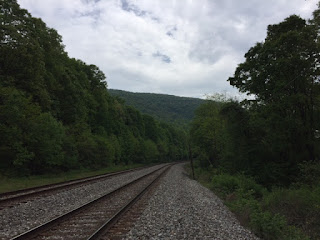Overall, the Laurel Highlands Hiking Trail is not especially strenuous. Most of its 70-mile course runs along the summit of Laurel Ridge, and there aren't a whole lot of ups and downs. But the seven southernmost miles are the exception, and they are downright brutal. This well-known overlook is well within the bounds of Ohiopyle State Park. At about two and a half miles in, this is as far as most people go.
But a friend and I just did an overnight on this end of the trail. We hiked in as far as the first Laurel Highlands Hiking Trail campground, at 6.3 miles. And it was arduous. Some of the climbs were savage, but the descents were even worse--at least for my aging knees. This is the Youghiogheny River meandering northward among the low mountains.
The Laurel Highlands are beautiful at any time of year, and May is especially nice. It was only 6.3 miles each way, and we saw day-hikers practically running the trail. But we did it with 30-pound backpacks. I gotta say, it really wore me out. Starting out at noon from the groovy little outdoorsy town of Ohiopyle, it all seemed so hopeful and, well, possible.
By the time we reached the little campground, we were more than ready to stop for the night. One of the great joys of backpacking is arriving at a strange place that is going to be home for one evening and one night--your own little makeshift home in the forest. Of course, the biggest ascent of all--known to LHHT thru-hikers as "Heart Attack Hill"--is just after this campground (northbound), but we didn't tackle it on this trek. We spent a pleasant evening and morning in this quiet spot, amid birdcalls and the gentle song of a nearby stream. The only noises from the outside world were the many trains that passed in the valley below. Though I go to the woods for silence, train noises are almost acceptable. Maybe because they're mournful.
Just because I'm always looking for shortcuts, I thought maybe we could trek back to the little town of Ohiopyle (and the car) along the railroad tracks... I really didn't want to have to carry my pack back over those 6.3 miles of trail. But alas, my friend was afraid to walk along such busy tracks. He thought a passing train cold throw a rock and hurt us. And so, we did it the hard way... When we came trudging back into town, I'm sure we looked like survivors of the Bataan Death March.
On the opposite side of the river, the beautiful rail trail known as "The Great Allegheny Passage" runs smoothly and evenly from Pittsburgh to D.C. But on this side of the river, all you've got is the LHHT...and it wants you dead.
























